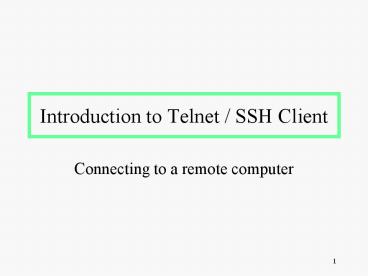Introduction to Telnet SSH Client - PowerPoint PPT Presentation
1 / 15
Title:
Introduction to Telnet SSH Client
Description:
Internet tools providing remote login capabilities to computers on the Internet ... Connect to Weather Underground at University of Michigan. telnet penpages.psu.edu ... – PowerPoint PPT presentation
Number of Views:543
Avg rating:3.0/5.0
Title: Introduction to Telnet SSH Client
1
Introduction to Telnet / SSH Client
- Connecting to a remote computer
2
What is Telnet / SSH Client?
- Internet tools providing remote login
capabilities to computers on the Internet - One computer can connect to another to use its
services - Connecting Privileges guest - usually logins
are not required full - requires username and
password.
3
How will I use telnet?
- Connect to unixs.cis.pitt.edu (full privilege)
- Connect to vms.cis.pitt.edu (full privilege)
- Connect to computers where you do not have an
account (guest privilege)
4
Some Telnet Examples
- telnet unixs.cis.pitt.edu login to your unixs
account - telnet locis.loc.gov Connect to the Library of
Congress - telnet to Pitt library system
- -http(or telnet)//library.pitt.edu
- telnet madlab.sprl.umich.edu 3000 -Connect to
Weather Underground at University of Michigan - telnet penpages.psu.edu -Connect to Penpages at
Penn State University
5
SSH
- SSH is typically used to log into a remote
machine and execute commands. - Secure Shell or SSH is a network protocol that
allows data to be exchanged over secure channel
between two computers. - SSH authenticates the remote computer and allows
the remote computer to authenticate the user, if
necessary. - An SSH client is a software program which uses
the secure shell protocol to connect to a remote
computer.
6
PuTTY
- PuTTY is a clinet program for the SSH and Telnet
network protocols. - PuTTY is available for both Windows and Various
Unix Platforms. - For instance, you can run PuTTY on a Windows
machine, and tell it to connect to a Unix
machine. PuTTY opens a Window. Then anything you
type into that window is sent straight to the
Unix machine, and everything the Unix machine
sends back is displayed in the window. So you can
work on the Unix machine as if you are sitting at
its console, while actually sitting somewhere
else.
7
Telnet from Windows NT
SSH Client Windows XP
8
(No Transcript)
9
Telnet from Unix
type command
10
Telneting from Unix
11
AFS
- Andrew File System (AFS) is a distributed
netwoked file system developed by CMU. - AFS has several benefits over traditional
networked file systems, particularly in the areas
of security and scalability. - One of the characteristic of AFS is that each
client caches files on the local filesytem for
increased speed on subsequent requests for the
same file. This allows limited filesystem access
in the event of a server crash or a network
outage.
12
AFS Tokens
- An AFS token grants you your own permissions in
an AFS cell. It verifies your identity to the
file system. - When you obtain an AFS Token?
- When you Enter your user name and password to a
SSH session. - When you enter your user name and password to a
Windows Login Screen.
13
AFS Tokens
- An AFS Token in only valid for 25 hours starting
from the time you log in. - When your AFS Token expires, you lose your AFS
identity in the cell. - On both Windows and Unix, you can type the
command tokens at a command prompt to check for
the existence and/or expiration date of AFS
tokens.
14
AFS Tokens
- How can you get an AFS token?
- Open the AFS authentication application
either from the padlock icon in your system tray
(beside the clock), or from the AFS program group
(Start? Programs? OpenAFS) and look on the tokens
tab to check, renew or discard your tokens.
15
Map Your Network Drive (Account) from AFS































